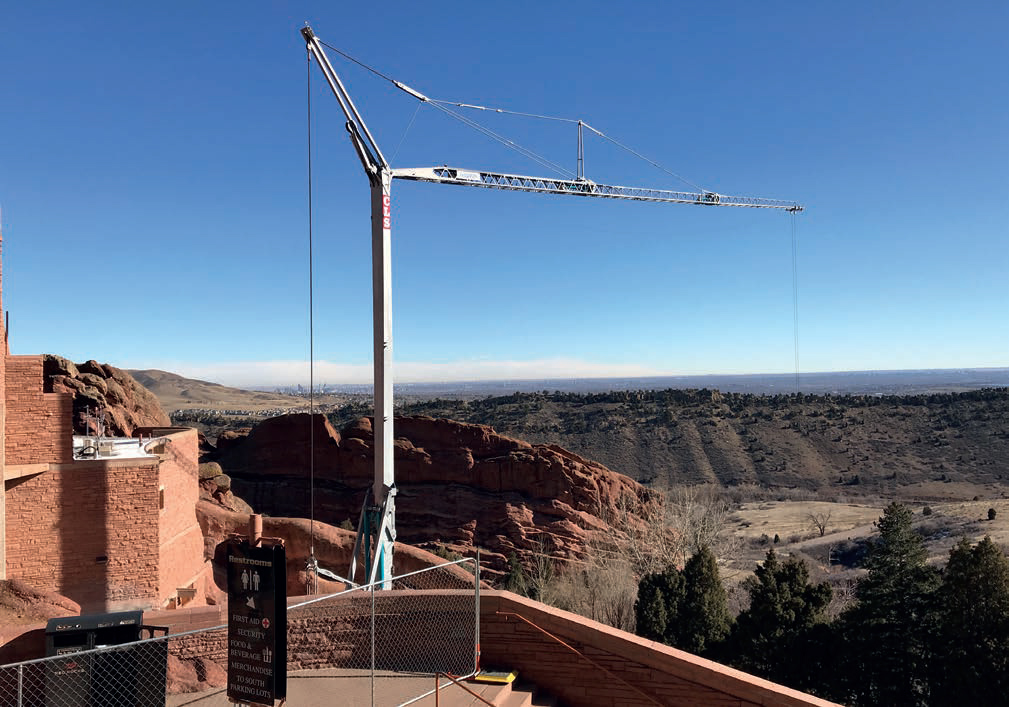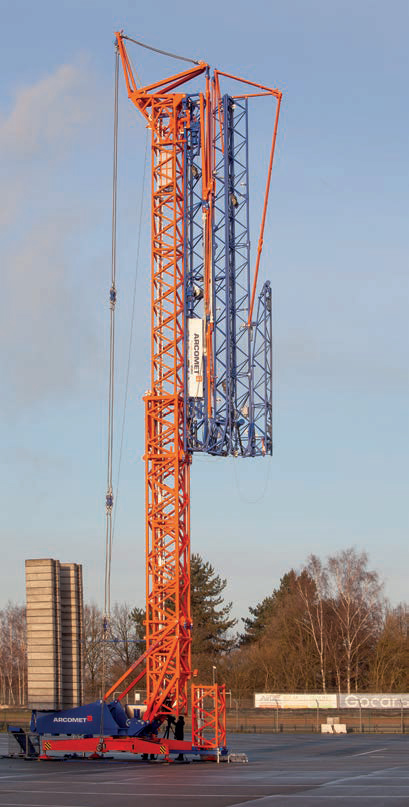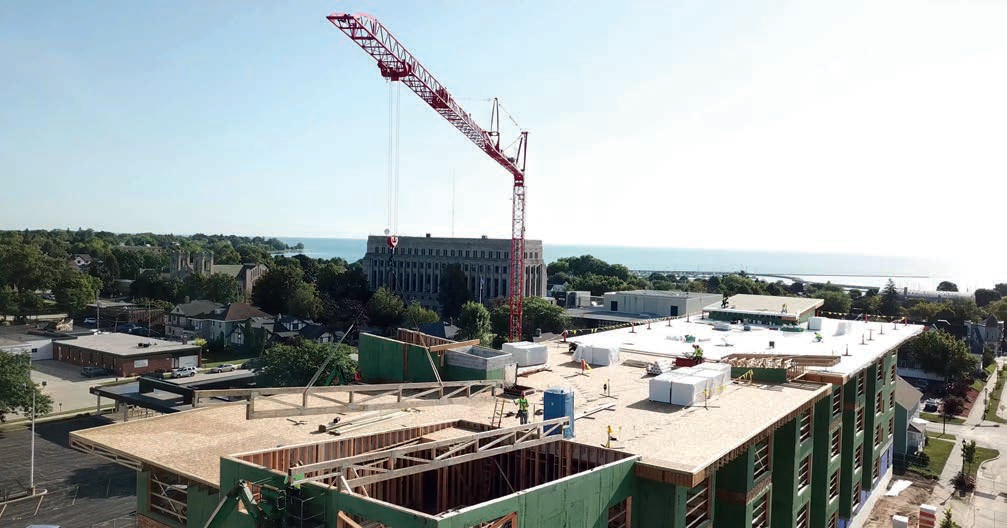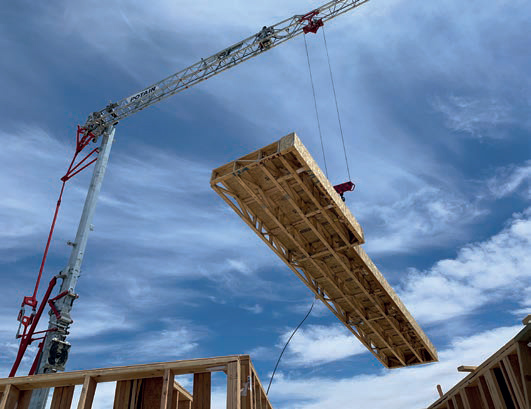It's all about self
7 October 2020The self-erecting crane has long been familiar in Europe, often used for low-rise building projects. But in the US, boomtrucks and other cranes occupy that niche. Julian Champkin asks why the self-erector has not penetrated that market.
“We see them in Europe – how come we haven’t seen them here before?” That was the question that customers used to put to Will Webb, whose Creative Lifting company is based in Brighton, Colorado.
“Because there was no-one to introduce them to the States,” was the answer he would give. Popular in Europe for decades, self-erectors are still a rarity in the US. It is not for want of trying, on the part of Will Webb at least. For decades he has been telling any potential client who will listen about the advantages of self-erectors.
Being based in Colorado helps. “Up in the mountains, in the ski-areas, they are ideal. For log houses they are great. You don’t need very heavy lifting but often on the steep slopes there is no room for laydown of materials, there is no road for a forklift to move things; a conventional tower crane would be hard to get up there and would be overkill when it arrived.
A self-erector can reach the whole site, or is easy to move if it cannot. It can do the work of a boom truck, or an all-terrain. So a self-erector is a good tool there. And if they are good for the mountains, why not use them downtown also?
It has taken several years, but now the self-erector has become the machine of choice for many apartment and condo projects.”
Webb says that self-erectors got off to a bad start in the US, as in past decades several dealers tried bringing them in from Europe; few succeeded. “Hook heights and capacities were small compared to tower cranes—so the large tower crane customers were not interested. Back then there was very little support and back-up from manufacturers; spares were hard to get.”
Worse, they were built to European requirements and to European specifications: “They ran off three-phase electricity— and that is not available on most smaller US jobsites. They are designed for 400V 50Hz, the US has 480V 60Hz power. So when you put 60Hz through them you got problems: motors are trying to run 20% too fast with too high voltage and tend to be short lived.
Movements were too fast and would not be smooth. Inverters have solved that problem, and most all cranes have them now, but back then it was different.”
Webb persevered in bringing them in, at first from Italy in the mid-1990s, from several different manufacturers in turn.“We knew what the potential was. We knew the specs that were needed. We wanted cranes that would run off single-phase. Hook height is big for us. We are always wanting more hook height.” He made trips to Italy to badger manufacturers.
“We convinced them. It took a lot of arguing with engineers, but we convinced them. So we shipped in single-phase machines, used half of them in our rental fleet and sold the others. In 2005 we sold around 15 cranes, which is a lot for us— we are a little company. And we doubled that the next year.”
“I compared all the Italian cranes, and Vicario had in almost every case the highest hook height by a fair amount. They had fall lines to 42m (138ft). We wanted 45m. ‘We are working on it’ they said; and now they have it. So Vicario is what we ended up with.”
Since 2008 he has been buying larger tower cranes, but not self-erectors, from Saez. Nine months ago Saez owners and engineers visited the company. They looked at different spec sheets and heard about the needs of the US market.
“The prototype from that visit is getting close. It is on a shake-out job now, so we should have it available by the end of the year.
It will lift 1.25t at 47m, plus 10% in super lift mode, 6t maximum capacity in two falls, and will operate on single phase or three phase power. Hook height will be 40.5m with no de rate,” says Webb. It will be marketed as the HT47.
Chad Jacobs of Pennsylvania based Stephenson Equipment is another promoter of self-erector cranes. “I have spent my life in cranes. I came here to Stephenson as a self-erector specialist. They reasoned that someone needs to spearhead the effort and get people interested. I come from the rental sector, so I know the costs and just how much self-erectors can save on a job.
“A lot of customers had never heard of them, or think tower cranes only come in large sizes. It is unheard of here for tower cranes to do residential homes, but of course that is what self-erectors are so good at. So there is a lot of opportunity for them. People use boom trucks for trusses and roof work, but this is one machine for the whole project. For steel framing they are perfect. As soon as there are more than three storeys, every other machine but the tower crane is at its limit, but a self-erector can reach 85ft.
“One thing that holds us back is licensing. You need a special licence to run a tower crane, and even though a self-erector is so much smaller and is operated from the ground not from a cab, it is grouped in with tower cranes and that is a hurdle to get past. Once I explain it, it is no big deal. We offer world-class training as part of our strategy for self-erectors.
“People are set in their ways. So the two obstacles to self-erectors are the licencing structure and simply that they are different.”
Stephenson is the direct source in the US for Montarent’s Montalift self-erectors. “For a small guy building a house, everything for him is economy. Montalift is a strong product, perfect for a small job or small builder. It has a half-hour setup. On a large site it can reach most or all of it, and you can move it easily to get to the hard bits. You could not do that with a standard tower crane. One of them should be on every build round here.”
Promotion
“The strategy has to be to educate the market,” says Jacobs. “I show customers a PowerPoint of the advantages: safety, labour-saving, working from tiny spaces, economy.
But I tell them that what I am selling is not iron, it is a concept, and a concept that is new to them.
The resistance is in getting the opportunity to show it; but once they have grasped the concept, we are there. They are not right for every job but where they work there is no better solution.
“There is definitely an increase in sales. Back in 2017 there were 600 self-erectors in the whole country; there were 18,000 in Germany! That shows how they have not penetrated everywhere yet. But there is double that number in the US now. Out west, in Seattle and Utah, they are starting to penetrate, more than on the East coast. Pennsylvania is a much tougher area.
“In the West Coast states sales are taking off. Why? Who knows. Maybe we have climbed that hill. Obviously something is now right. One problem used to be that all the marketing material was European based.
"There was nothing on social media that showed them at work in the States. But Potain has done a really good job with their ‘Build Better’ campaign, showing them in use right now. They have been very supportive for the US market.
“I have a recent order from a large-scale roofer who has booms and telehandlers. They had other options but they chose a self-erector, so that was big for me. If it works for him it will work across the board.”
“The main reason the US market been so slow to embrace self-erectors is that there has been a lack of promotion on a nationwide level,” says Tony Cappellaro of Virginia-based P&J Arcomet, part of the Uperio Group and exclusive partner of Arcomet selferectors for USA and Canada.
“Promotion has been mostly limited to small geographical areas; some regions have embraced the concepts when other regions have not seen them much. The US market has always been a large tower crane market for high-rise buildings.” For most contractors, a tower crane would be the familiar option that would first spring to mind unless the advantages—indeed the existence— of the self-erector has been made known to them.
The market, however, is becoming more aware of the type, and more accepting also. “For sure, we are receiving a lot more inquires than we did only a few years ago,” he says, “as people see the value in their versatility.
“The ideal type of construction project for self erectors is a two-to-seven storey wood frame building. Traditionally these buildings are built by mobile cranes and/or high reach telehandlers; but those are inefficient, take up a lot more room and require constant attention.”
Low- to medium-rises are not the only application, though: “They are also capable of doing small concrete pour-in-place structures.”
Will Webb spoke of the past lack of adaption to US specifications or needs. Cappellaro echoes the point: “As self erectors become more prevalent in job sites across North America, they will be required to be fully UL (USA) and CSA (Canada) certified and to have a remote control with a display showing loads, trolley position and wind speed. In some states this requirement is already in place.
Another item that we see a lot of and that may hold self-erectors back is that operators in the US are now NCCCO certified and want to work in the comfort and perceived security of a cab. In Europe operators do not require cabs on the cranes and self-erectors are not equipped with cabs.”
It may be that the self-erector has at last broken the US demand barrier: sales are increasing.
“Things were strong right before the Covid pandemic hit, but demand has slowed due to recent worldwide events. Sales are moving in the right direction though and we are very bullish on the long-term prospects. In the USA, the West Coast is probably the largest user of self-erectors but there are pockets throughout the country.”
Europe’s smaller-capacity versions, though, are still not fully appreciated: “Larger capacity cranes for commercial construction are more popular.” The Arcomet A50 Eco, he says, is the only fully UL/CSA certified self-erecting crane in the market today, and its hook height, jib length and high tip capacity make it ideal for the US market. The jib length is 50m (164ft), it has seven different hook heights up to 36m, and a maximum capacity of 8t.
“We recently had an A50 Eco erected in downtown Washington DC. The space was limited and there was no way a mobile crane could have worked for the customer. The A50 gave them the reach and height they needed, and there was a significant cost savings as well.
“P&J Arcomet has its own fleet of the Arcomet line of self-erectors as well as a network of dealers who work exclusively with us.
That helps to promote the crane. But we need also to educate our customers in what the cranes can do, and for that we provide several levels of training. For our dealers we have a full hands-on training course with a classroom, as well as in-the-field technician training that covers safe erection, dismantling and trouble-shooting procedures.
The current generation of Arcomet self-erectors has a wonderful self-diagnostic program which the service technician can review on their laptop prior to ever coming on the site. This means there need be very little downtime. We also assist our dealers with sales tools and manufacturer supported financing if needed.”
Liebherr has been targeting the US for several years now. “The US market is in our focus,” says Christoph Brandenburg, their North America sales manager. “We started there with the 32 TT and we showed our first 81 K at the Conexpo show in 2011. Since then our customers have got to know the concept and are convinced of the benefits of this generation of cranes.
“Fast-erecting cranes are perfect machines for housebuilding, bridge-building and industrial buildings of heights up to about 40m. With a steep angle on the jib we can reach hook heights of about 60m.
"Fast-erecting cranes are very flexible, with different hook heights, jib lengths and high performance in various load capacities.”
“The basic layouts of our European and US cranes are similar,” he says, “but UL requirements and lower maximum axle loads makes a US version necessary. All Liebherr fast-erecting cranes are delivered in UL configuration into the US market. Fast-erecting cranes are getting more and more popular in this market.”
He, too, reports that the larger capacity self-erectors are the more favoured. “In Europe the starting size is about 25tm. In the US big fast erecting cranes are running at a size of about 50tm. Liebherr delivers mostly our 81 K.1 fast erector and the new 125 K. This is the biggest fast-erecting crane in the market.”
First presented in March 2019, the 125 K has a radius of 55m and an initial hook height of 29.5m as standard. Five additional tower sections can be inserted to reach a total hook height of 41.5m. This means that even major construction projects can be mastered. If the hook height still isn’t sufficient, the 30° steep angle jib position gives a 65.5m hook height. The Liebherr crane has an 8t maximum load capacity and using the Load-Plus function with a 55m radius at the jib head, can lift 1.3t. It has five radius options, from 35 to 55m.
“Demand in different states often depends on the dealer network and the rental fleets,” he says. “We have been working very well with Morrow for many years and their network is very big in the States. We have been promoting these cranes for many years now and they are getting more and more popular. Training for the fitters is done in Morrow’s centres and in the Liebherr factory in Germany.”
Building apartments in Nevada
Potain launched their Hup M 28-22 self-erector at ConExpo 2020 earlier this year. One unit is now at work helping erect a 192-unit apartment complex in northwest Reno, Nevada. The crane belongs to local general contractor Davis Company and is the first Hup M 28-22 to be deployed in North America.
The crane is supporting several different tasks at the site, eliminating the need for other equipment such as forklifts, and therefore also reducing labour costs.
“This is a prefab job and the crane is very useful to set walls, floor modules, and trusses, among many other tasks,” said Jim Smith, job foreman at Davis Company. “All of these jobs would be much harder without a self-erecting tower crane. The crane places the prefab components right where they go. It saves us time and money to be able to just lift them directly off the truck to their location on the construction site.”
“Any of our other cranes would require an eight to ten-man crew to get the job done. The Hup M 28-22 means that we need only a six-man crew,” said Dennis Davis, founder and owner of Davis Company. “This saves us time by allowing us to use our crew in other areas of the job at the same time if needed, and if they are not needed on the site they can be used on other jobs, which saves us still more money in labour costs.”
Why did he chose the crane over more conventional equipment such as telehandlers? “The answer is simple: the Hup M 28-22's reach and tip capacity is much greater,” he said.
Potain dealer Compass Equipment, based in nearby Gilbert, Arizona, supplied the crane to Davis Company. It should remain at the site until early 2021, when the development is scheduled for completion.
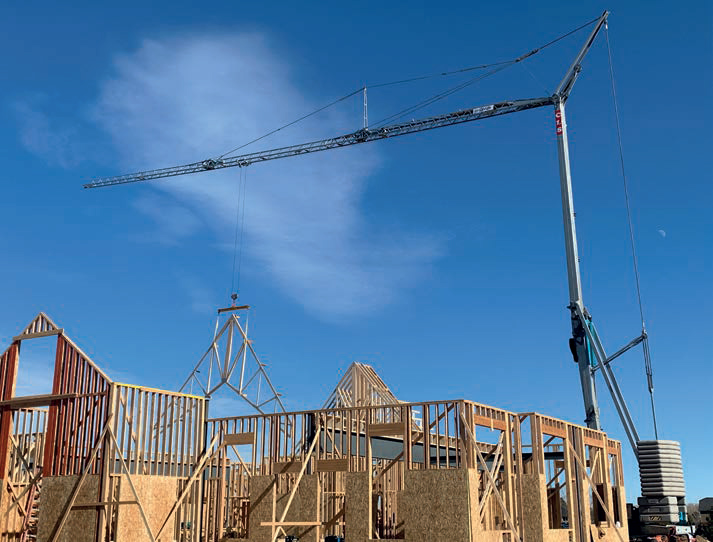 Self-erectors are ideal for roof trusses and woodframed building. In the picture: one of Creative Lifting’s Vicario machines.
Self-erectors are ideal for roof trusses and woodframed building. In the picture: one of Creative Lifting’s Vicario machines.
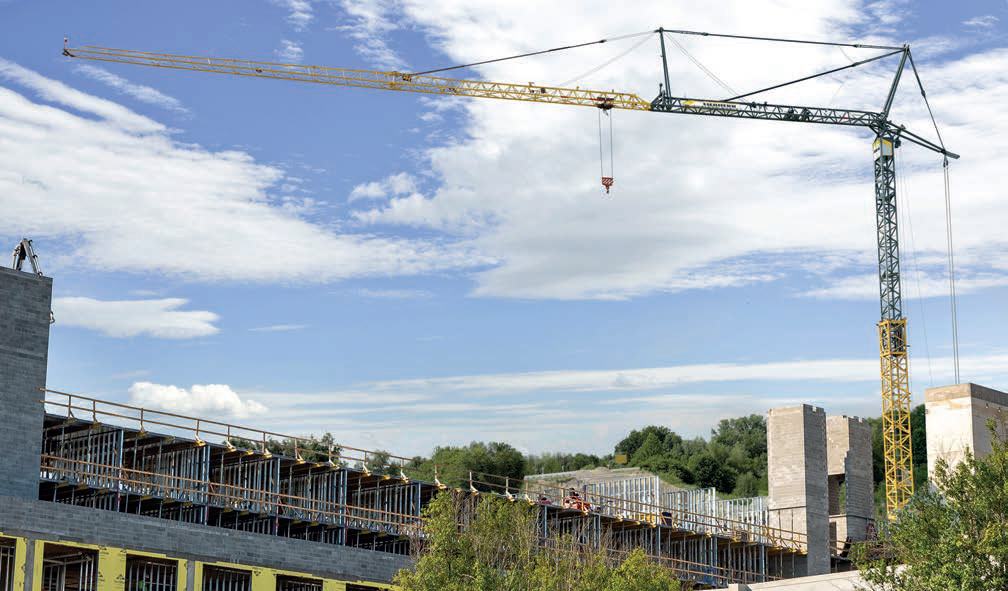 A Liebherr 125 K self-erector. Ohioheadquartered ALL Tower Crane, a division of the ALL Family of Companies, has recently added a Liebherr 125 K to its fleet. “The Liebherr 125 K offers an additional 16ft of jib and 20ft of hook height over what was previously our largest selferector,” said Sam Moyer, general manager of ALL Tower Crane. The unit also features Liebherr’s Load Plus function, which allows the crane to increase load capacity by up to 20% by reducing line speed. The company also recently added a Potain Igo T 85 A self-erector to its fleet.
A Liebherr 125 K self-erector. Ohioheadquartered ALL Tower Crane, a division of the ALL Family of Companies, has recently added a Liebherr 125 K to its fleet. “The Liebherr 125 K offers an additional 16ft of jib and 20ft of hook height over what was previously our largest selferector,” said Sam Moyer, general manager of ALL Tower Crane. The unit also features Liebherr’s Load Plus function, which allows the crane to increase load capacity by up to 20% by reducing line speed. The company also recently added a Potain Igo T 85 A self-erector to its fleet.
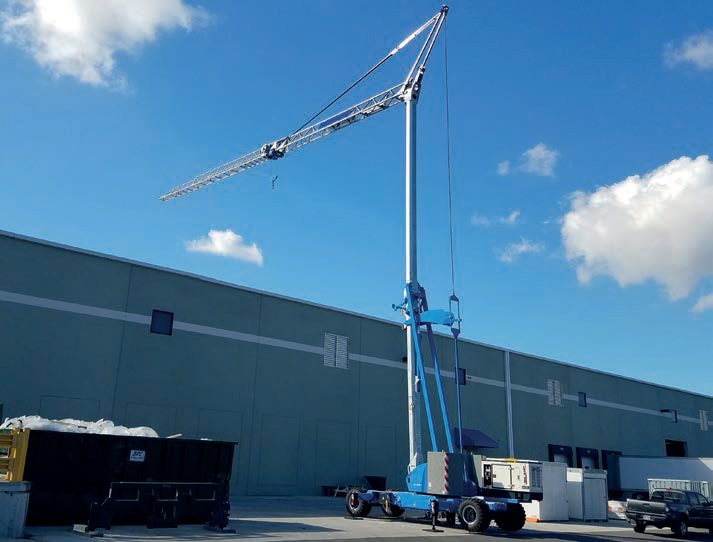 Stephenson Equipment’s Montalift M21 is a Potain Igo MA21 mounted on its own self-propelled chassis.
Stephenson Equipment’s Montalift M21 is a Potain Igo MA21 mounted on its own self-propelled chassis.
